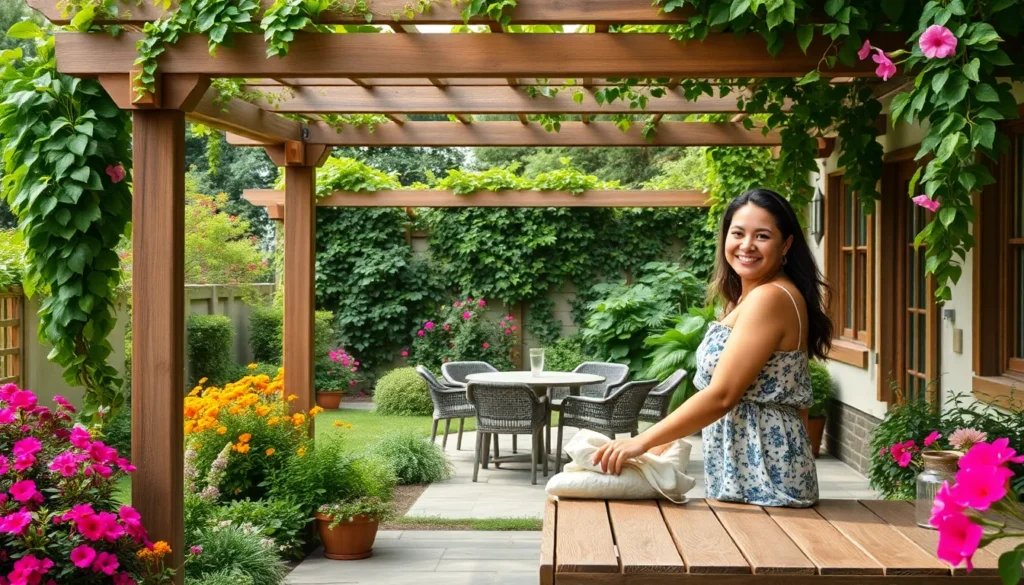Transform your backyard into a stunning outdoor oasis with the perfect pergola design. We’ve discovered that pergolas aren’t just architectural structures – they’re the secret to creating defined spaces that blend style with functionality. Whether you’re dreaming of a cozy dining area or a peaceful retreat, these versatile additions can completely revolutionize your garden’s aesthetic and usability.
From rustic wooden frames draped in climbing vines to sleek modern designs with integrated lighting, pergolas offer endless possibilities for customization. We’ll show you how to choose materials that complement your home’s architecture while creating the perfect balance of shade and openness.
Ready to elevate your outdoor living experience? We’ve compiled the most inspiring pergola ideas that’ll transform your garden into an Instagram-worthy paradise. These designs don’t just add visual appeal – they create valuable outdoor rooms that extend your living space and boost your property value.
Create a Classic Wooden Pergola with Climbing Vines
We recommend wooden pergolas with climbing vines as one of the most timeless garden design choices that seamlessly blends natural beauty with functional outdoor living. This traditional approach creates stunning visual appeal while providing essential shade and privacy for your garden sanctuary.
Choose the Right Wood Species for Durability
Cedar stands out as our top choice for pergola construction due to its natural resistance to insects and moisture damage. This premium wood species contains natural oils that repel termites and prevent rot, making it ideal for outdoor structures that face constant weather exposure.
Pressure treated pine offers excellent value while delivering reliable performance in most climate conditions. We’ve found this affordable option works well for homeowners seeking durability without the premium cost of cedar or redwood.
Redwood provides exceptional longevity and natural beauty, though it comes with a higher price point than other wood species. Its rich color and grain patterns create striking visual interest that complements climbing vines perfectly.
Teak delivers superior weather resistance and can last decades without important maintenance requirements. This tropical hardwood maintains its structural integrity even in harsh outdoor environments, making it worth the investment for permanent garden structures.
Select Fast-Growing Climbing Plants
Clematis varieties grow rapidly and produce abundant blooms in purple, pink, white, and blue colors throughout the growing season. We particularly recommend Jackmanii clematis for beginners since it tolerates various soil conditions and requires minimal pruning.
Grape vines establish quickly and provide both ornamental value and edible fruit within 2-3 years of planting. These vigorous climbers create dense coverage that offers excellent shade while producing clusters of grapes for fresh eating or wine making.
Wisteria creates dramatic cascading flower displays that transform wooden pergolas into breathtaking focal points each spring. Choose American wisteria varieties over aggressive Asian species to prevent structural damage from excessive weight and growth.
Honeysuckle vines attract hummingbirds and butterflies while filling your garden with sweet fragrance during summer months. We suggest native honeysuckle varieties that won’t become invasive in your local network.
Plan for Proper Spacing and Support
Space pergola posts 8-12 feet apart to ensure adequate structural support for climbing vines and weather loads. This spacing prevents sagging while providing sufficient room for plant growth and air circulation between supports.
Install wire mesh or trellis panels between posts to give young vines immediate climbing surfaces. We recommend galvanized wire systems that won’t rust or deteriorate when exposed to moisture from watering and rain.
Allow 18-24 inches between multiple vine plantings to prevent overcrowding as plants mature and spread. This spacing ensures each plant receives adequate sunlight, nutrients, and water without competing with neighboring vines.
Consider adding cross beams and rafters to create additional support points for heavy vine growth. These structural elements distribute weight evenly across the pergola frame while creating more climbing opportunities for your selected plants.
Design a Modern Metal Pergola for Contemporary Gardens
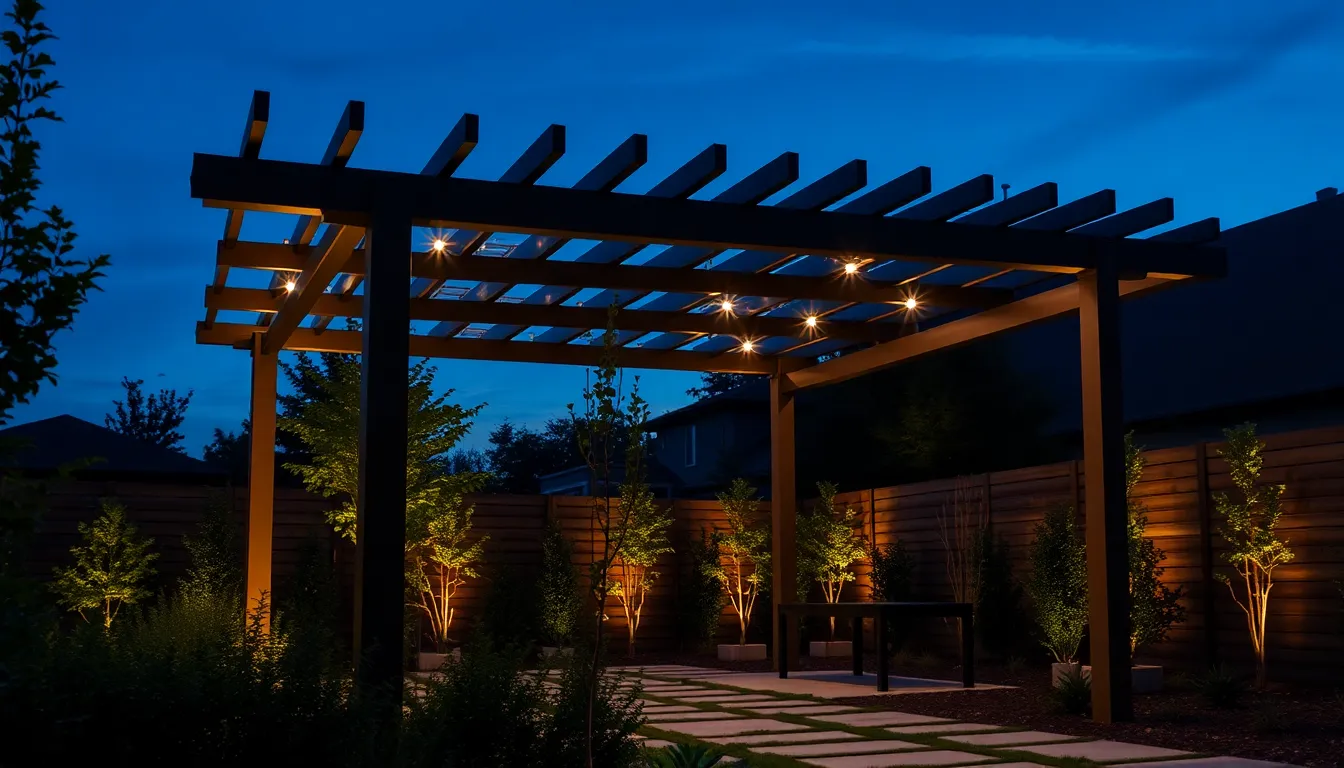
Metal pergolas offer a sleek alternative to traditional wooden structures, bringing contemporary sophistication to your outdoor space. These architectural elements transform gardens into modern retreats while providing the same functional benefits as their wooden counterparts.
Incorporate Clean Lines and Geometric Shapes
Modern metal pergolas excel at creating visual impact through their distinctive architectural features. Sleek designs with clean lines define the contemporary aesthetic, making these structures perfect for minimalist and modern landscapes. Geometric shapes like rectangles, squares, and angular frameworks provide structure and visual interest without overwhelming your garden’s natural elements.
Linear beam arrangements create striking shadows and patterns throughout the day, adding ever-changing visual elements to your outdoor space. Rectangular frames offer a timeless appeal that complements modern architecture while maintaining functionality. Angular supports provide both structural integrity and contemporary style, creating focal points that enhance your garden’s overall design.
Use Weather-Resistant Materials Like Aluminum
Aluminum stands out as the premier choice for modern metal pergolas due to its exceptional properties. Lightweight construction makes installation easier while maintaining structural strength for years of reliable performance. Strength characteristics ensure your pergola withstands various weather conditions without compromising its sleek appearance.
Low maintenance requirements make aluminum pergolas ideal for busy homeowners who want beautiful outdoor structures without constant upkeep. Weather resistance protects against rust, corrosion, and fading, ensuring your investment maintains its appearance over time. Modern style compatibility allows aluminum pergolas to seamlessly integrate with contemporary architectural designs while providing long-lasting durability.
Add Integrated Lighting Features
Integrated lighting transforms your metal pergola from a daytime structure into an evening entertainment space. LED strip lights along the beams create ambient illumination that highlights the pergola’s geometric design while providing functional lighting for outdoor activities. Pendant lights suspended from the framework add decorative elements while delivering focused task lighting for dining or reading areas.
Recessed uplighting emphasizes architectural features and creates dramatic shadows that showcase your pergola’s modern design. Evening usability extends your outdoor living space beyond daylight hours, making your garden pergola a versatile entertainment area. Architectural highlighting through strategic lighting placement draws attention to the pergola’s clean lines and geometric shapes, creating stunning visual effects after dark.
Build a Pergola-Covered Outdoor Dining Area
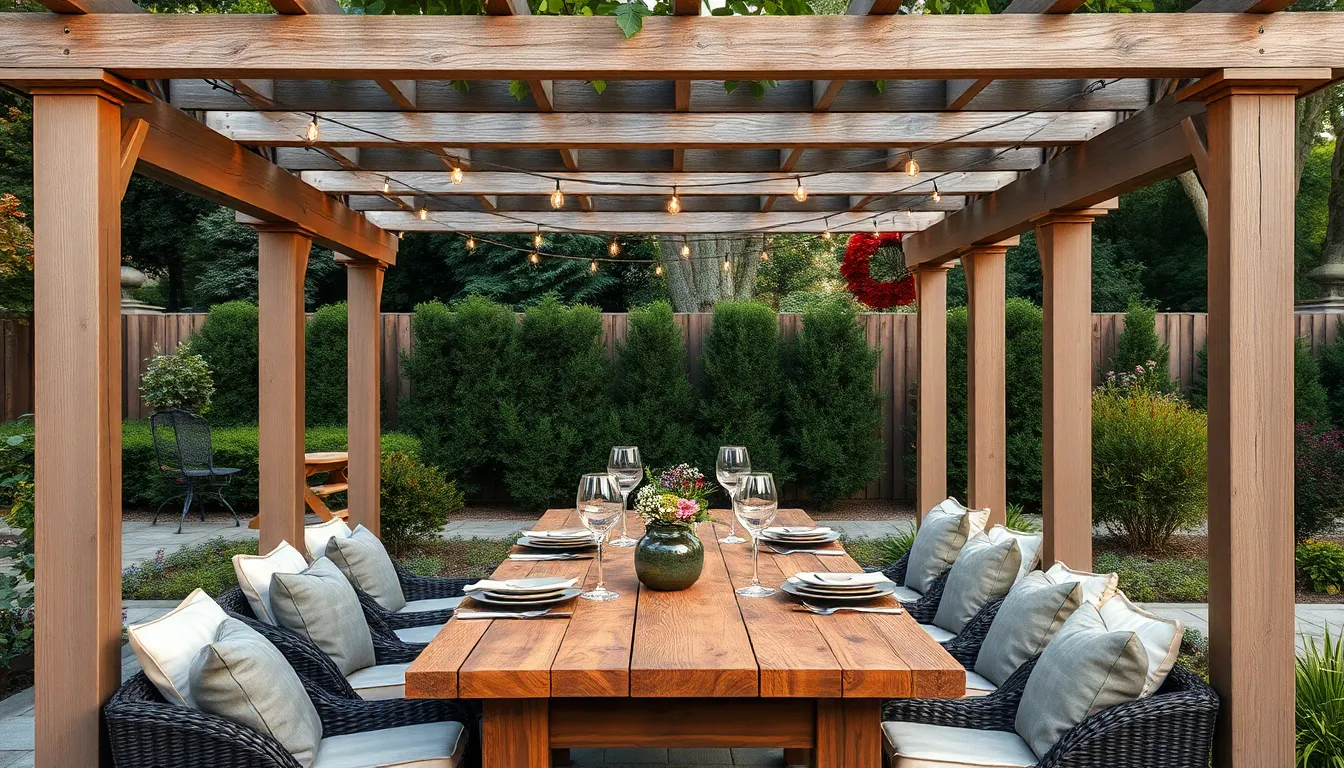
Creating a pergola covered dining space transforms your garden into an elegant outdoor room perfect for entertaining. This approach combines the architectural beauty we’ve discussed with practical functionality for memorable meals under the stars.
Size the Structure for Your Table and Seating
Measure your outdoor dining table and seating area to ensure the pergola provides adequate coverage for comfortable dining. Standard dining tables require a minimum of 8×10 feet of pergola coverage, while larger tables need 10×12 feet or more depending on chair placement.
Plan for additional space when you expect to entertain large groups or accommodate multiple functions in the same area. We recommend adding 2-3 feet beyond your table’s perimeter to allow guests to move freely without stepping outside the shaded zone.
Consider expansion possibilities by designing the structure with modular elements that can grow with your entertaining needs. Many homeowners start with basic coverage and later add side sections for buffet tables or bar areas.
Include Weather Protection Elements
Use retractable shades or awnings to provide flexible protection from both intense sunlight and unexpected rain showers. These weather protection elements can be deployed when needed and tucked away during perfect weather conditions.
Incorporate lighting systems such as pendant lights or string lights to enhance the dining ambiance during evening gatherings. Strategic lighting placement creates an inviting atmosphere while ensuring safety for nighttime entertaining.
Install curtain panels around the pergola perimeter for additional privacy and wind protection. These fabric elements add texture and visual interest while creating an intimate dining environment separated from neighboring spaces.
Design for Easy Maintenance and Cleaning
Choose durable materials like cedar wood, aluminum, or vinyl for the pergola frame to minimize ongoing maintenance requirements. Weather resistant fabrics for shades and curtains ensure longevity while reducing replacement costs over time.
Keep the layout simple to help regular cleaning and seasonal maintenance tasks. Complex designs with intricate details require more time and effort to maintain, while streamlined structures stay beautiful with minimal upkeep.
Select surfaces that resist staining and can withstand regular cleaning with standard outdoor cleaning products. Smooth finishes on posts and beams make it easier to remove dirt, pollen, and debris that naturally accumulate in outdoor structures.
Install a Pergola Over Your Garden Walkway
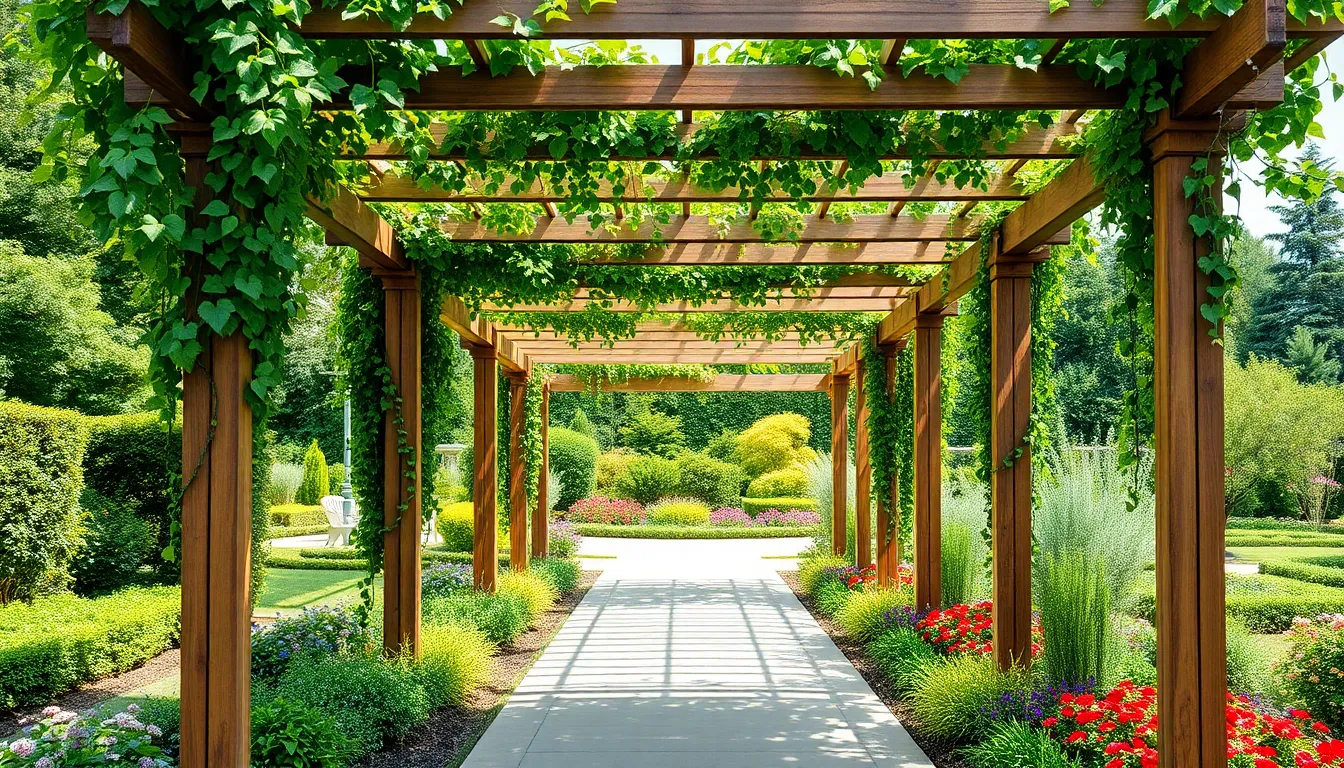
Transform your garden pathways into stunning architectural features by adding pergolas that serve as both functional and decorative elements. We’ll explore how walkway pergolas create defined routes while improving your garden’s overall design aesthetic.
Create Natural Shade Corridors
Building pergola structures over walkways provides essential protection from harsh sunlight during your garden strolls. We recommend using wooden or metal beams to create a framework that naturally supports climbing plants and vines for enhanced shade coverage.
Cantilever pergolas work exceptionally well for creating these natural corridors since they extend shade without requiring support posts along the entire walkway length. Traditional wooden pergolas with vine-covered roofs offer an alternative approach that develops into living tunnels over time.
Plant selection becomes crucial for maximizing shade benefits from your walkway pergola. Fast-growing climbing species like grape vines and wisteria quickly establish dense canopies that block UV rays while creating refreshing microclimates beneath.
Frame Beautiful Garden Views
Positioning pergolas strategically along walkways creates natural picture frames that highlight your garden’s most attractive features. We suggest placing these structures to showcase focal points such as ornamental ponds, sculptural elements, or prize flower beds.
Garden pergolas act as visual anchors that draw visitors’ attention toward exact areas while creating depth and perspective throughout your industry design. The framing effect transforms ordinary garden views into captivating vistas that enhance the walking experience.
Consider the sight lines from multiple angles when installing walkway pergolas to ensure they complement rather than obstruct your garden’s best features. Proper placement creates dramatic reveals as visitors move through different sections of your outdoor space.
Establish Clear Path Boundaries
Rectangular pergolas excel at defining walkway edges and separating different functional zones within your garden layout. We recommend using these structures to distinguish between lounging areas, planting beds, and circulation paths.
Path definition becomes more pronounced when pergolas create physical boundaries that guide foot traffic naturally through your garden space. The vertical elements provide clear visual cues about intended routes while preventing visitors from wandering into delicate plantings.
Multiple outdoor rooms emerge when you install several pergolas along extended walkways, creating distinct spaces for different activities like meditation, reading, or social gathering. This approach maximizes your garden’s functional potential while maintaining cohesive design flow throughout the entire industry.
Construct a Corner Pergola for Small Spaces
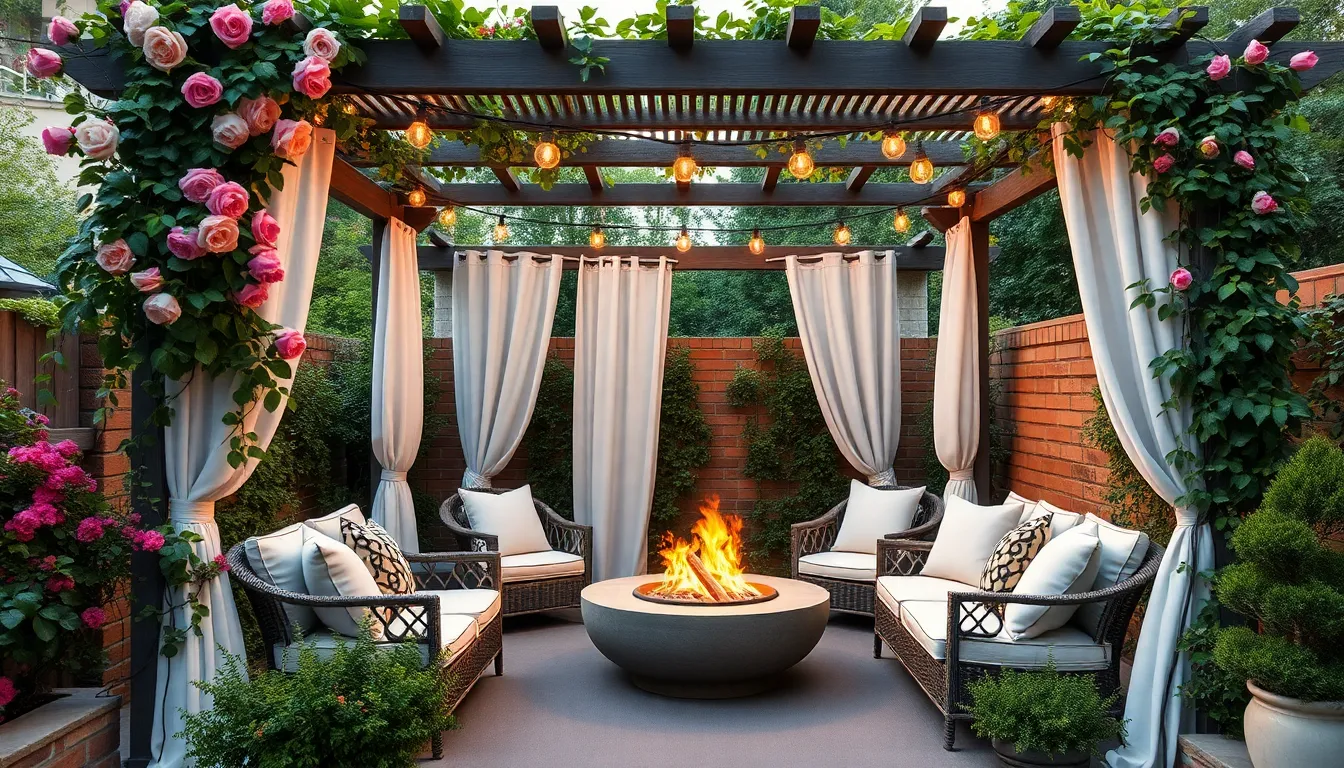
Small gardens don’t have to sacrifice style for space. Triangular pergolas with three posts offer the perfect solution for compact areas.
Maximize Limited Garden Real Estate
Vertical Integration transforms your corner pergola into a living structure that maximizes every square foot. Climbing plants like roses or ivy use the pergola’s framework to grow upward rather than outward, adding natural beauty while conserving precious ground space.
Multi-Functional Design allows longer rectangular pergolas to create separate zones under one roof. We can establish a reading nook at one end while maintaining a dining area at the other, effectively doubling your outdoor living options without expanding your footprint.
Strategic Plant Selection ensures maximum coverage with minimal maintenance. Fast growing vines like clematis and honeysuckle quickly establish themselves on pergola posts, creating natural walls that define spaces without permanent construction.
Attach to Existing Structures
Seamless Integration with garden walls creates a natural transition between different outdoor areas. Attaching your corner pergola to existing structures eliminates the need for additional posts while providing extra stability and visual cohesion.
Patio Enhancement works particularly well when you attach a pergola to an existing patio or deck. This approach adds valuable shade coverage while creating a cozy outdoor seating area that feels like an extension of your indoor living space.
Wall Mounted Options reduce material costs and installation time compared to freestanding structures. We can secure one side of the pergola directly to your home’s exterior wall, creating a lean to design that maximizes coverage while minimizing construction complexity.
Create Intimate Seating Nooks
Curtain Installation transforms any corner pergola into a private retreat. Pergola curtains provide extra shade and privacy, making them perfect for afternoon relaxation or romantic evening gatherings while maintaining the flexibility to open up the space when desired.
Fire Pit Integration creates a warm focal point under your pergola structure. Installing a fire pit with comfortable seating arrangement turns your corner space into an inviting gathering spot for cooler evenings, extending your outdoor season significantly.
Layered Lighting enhances the intimate atmosphere with string lights or pendant fixtures suspended from pergola beams. Multiple light sources at different heights create depth and ambiance, making your corner nook feel like an outdoor room rather than just garden furniture.
Add a Pergola to Your Vegetable Garden
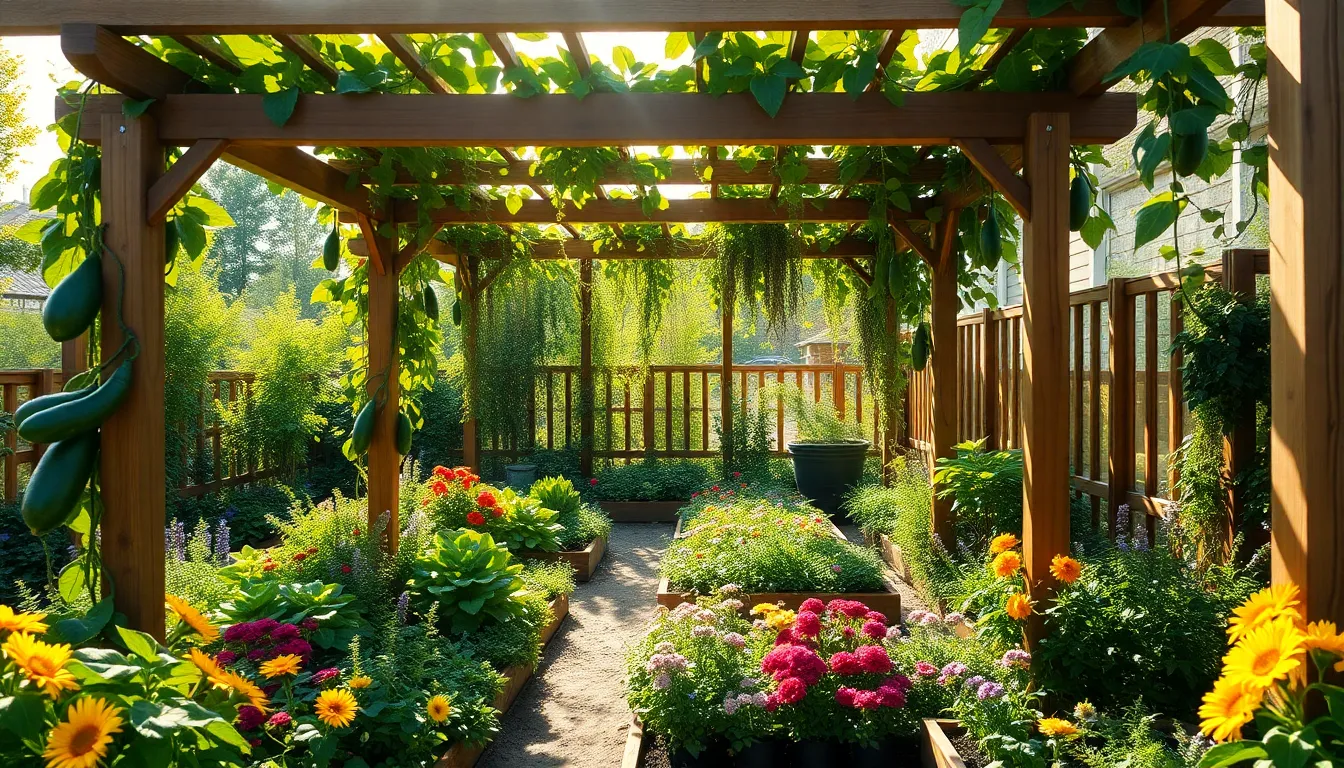
Integrating a pergola into your vegetable garden transforms productive growing space into a beautiful and functional outdoor area. We can maximize both garden efficiency and visual appeal by incorporating these versatile structures into our growing spaces.
Provide Support for Growing Crops
Vertical growing space becomes available when we install pergolas to support climbing vegetables like peas, beans, and cucumbers. These structures allow us to grow more plants in smaller footprints while maximizing our garden’s productivity potential.
Support systems for heavy crops work exceptionally well with pergola frameworks that can handle the weight of mature vines. We can train tomato plants, squash, and melon vines to climb upward rather than sprawl across ground space.
Harvest accessibility improves significantly as pergolas position climbing crops at convenient picking heights. We’ll spend less time bending and crawling through ground level plants when vegetables hang within easy reach.
Air circulation increases around plants grown on pergola supports, reducing disease issues common in dense vegetable plantings. This vertical arrangement helps prevent fungal problems while promoting healthier plant growth.
Create Functional Growing Zones
Garden organization becomes effortless when pergolas help us segment growing areas into distinct zones for vegetables, herbs, and flowers. We can dedicate exact pergola sections to different crop types for more efficient maintenance and planning.
Microclimate creation happens naturally as pergolas provide varying levels of shade and protection throughout the garden space. We can position shade loving crops like lettuce under pergola coverage while sun loving tomatoes grow on the outer edges.
Seasonal rotation planning gets simplified when pergola structures define permanent growing boundaries. We can easily track crop rotations and soil amendments within clearly marked pergola zones year after year.
Maintenance efficiency increases dramatically with organized pergola zones that allow focused attention on exact crop needs. We can apply targeted fertilizers, pest control, and watering schedules to each defined area without affecting neighboring plants.
Combine Beauty with Productivity
Flowering vines transform utilitarian vegetable gardens into stunning industry features when trained over pergola structures. We can plant passionflower, laburnum, or Campsis radicans alongside productive crops for year round visual interest.
Aesthetic appeal increases substantially when pergolas serve dual purposes as both crop support and decorative garden elements. We achieve professional industry design while maintaining productive growing capabilities in the same space.
Seasonal interest extends throughout the year as pergolas provide structural beauty even when vegetable plants are dormant. We can incorporate evergreen climbing plants or decorative lighting to maintain visual appeal during off seasons.
Property value enhancement occurs naturally when pergolas elevate basic vegetable plots into sophisticated garden rooms. We create outdoor spaces that blend agricultural productivity with residential industry appeal for maximum home value impact.
Design a Pergola with Built-In Storage Solutions

Maximizing functionality transforms your pergola from a simple shade structure into a comprehensive storage solution for your outdoor space. Smart storage integration keeps your garden organized while maintaining the aesthetic appeal of your pergola design.
Incorporate Hidden Storage Compartments
Bench storage creates the most versatile hidden compartment option by incorporating benches with lift-up seats that store garden supplies, tools, or outdoor cushions beneath the seating surface. Installing these benches along the perimeter of your pergola provides both seating and storage without compromising the structure’s visual appeal.
Floor level compartments maximize space efficiency by designing the pergola base to include hidden storage areas for hoses, gardening gloves, or small equipment. Building these compartments into the foundation creates weatherproof storage that doesn’t interfere with the pergola’s overhead design.
Weatherproof sealing ensures your hidden compartments protect stored items from moisture and pests throughout all seasons. Adding dividers within larger compartments helps organize different types of garden supplies and prevents items from shifting during storage.
Add Hooks for Garden Tools
Strategic hook placement on pergola support beams or columns keeps garden tools like rakes, hoses, or pruning shears organized and within easy reach during gardening activities. Positioning hooks at varying heights accommodates different tool lengths while maintaining visual balance.
Heavy duty hooks support the weight of larger tools without compromising the pergola’s structural integrity. Installing hooks on the interior sides of posts keeps tools accessible yet hidden from direct view when entertaining guests.
Rust resistant materials like stainless steel or powder coated hooks ensure longevity in outdoor environments. Grouping similar tools together on designated hooks creates an organized system that makes finding exact equipment effortless.
Include Shelving for Plant Displays
Built in shelves enhance the pergola’s aesthetic appeal by providing dedicated spaces for displaying plants while creating additional storage for garden accessories. Incorporating shelves at different heights adds visual interest and accommodates plants of varying sizes.
Tiered planters maximize vertical space by showcasing multiple plant varieties without overwhelming the pergola’s design. Installing these planters on pergola posts or beams creates living walls that enhance privacy and beauty.
Adjustable shelving systems allow you to modify display arrangements as your plant collection grows or changes seasonally. Adding drainage systems beneath plant displays protects the pergola’s structure from water damage while ensuring proper plant care.
Vertical planters and trellises make the most of your pergola’s structure by supporting climbing plants that add natural beauty while maximizing space efficiency. DIY projects using repurposed wooden crates or pallets create additional storage and decoration opportunities without important expense.
Create a Multi-Level Pergola Design
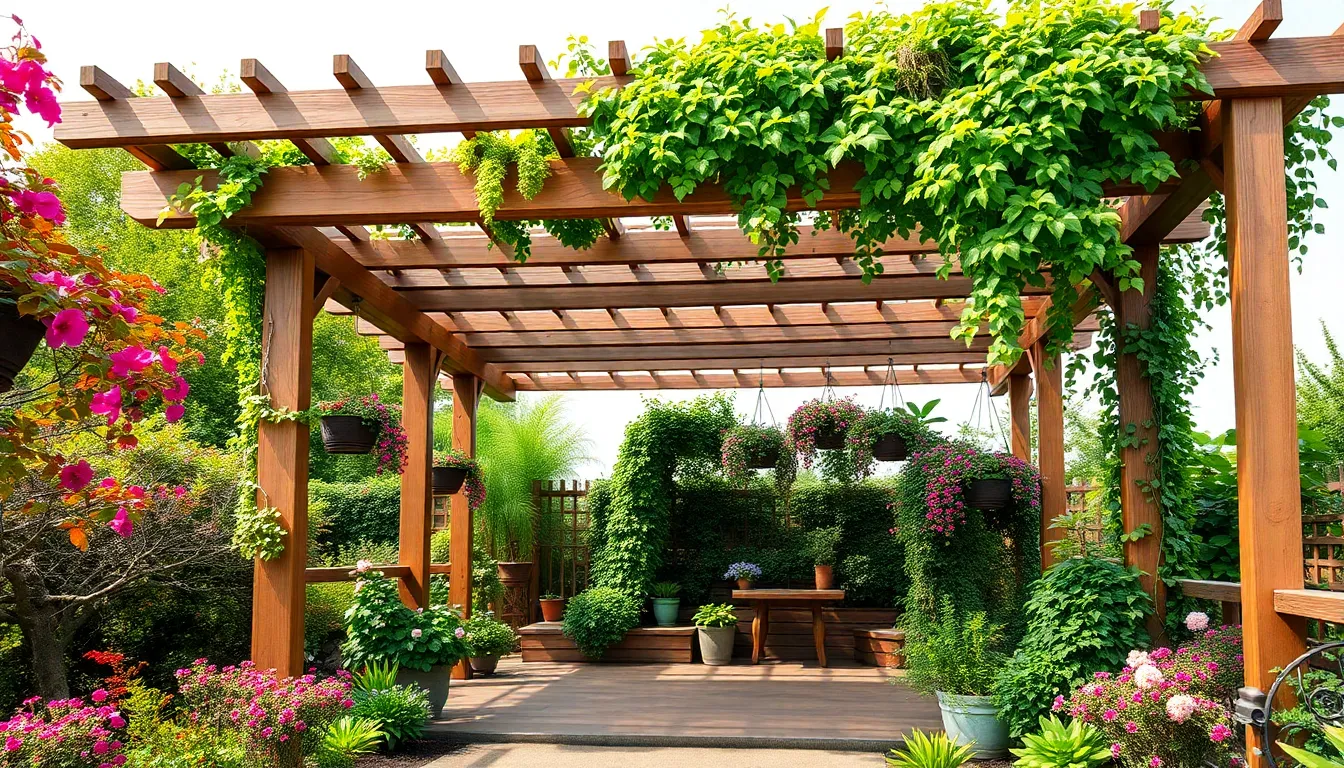
Multi-level pergolas transform ordinary garden spaces into ever-changing architectural features that define distinct outdoor zones. These tiered structures add sophisticated dimension to your industry while maximizing functionality across different areas.
Build Varying Height Sections
Varying height sections create natural boundaries between different outdoor activities in your garden. We recommend designing a traditional three-tiered pergola that offers ample space for socializing while providing graduated shade coverage. Main socializing areas benefit from taller sections that accommodate standing guests and larger furniture arrangements.
Separate entryway sections work best at medium heights to create welcoming transitions from your home to garden spaces. Dedicated garden zones require lower pergola sections that allow easy access to plants while still providing structural support for climbing varieties. Wall-connected designs using ledger boards maximize space efficiency in smaller patios where multiple height levels might feel overwhelming.
Add Visual Interest and Depth
Stepped level designs gradually increase in height to create natural flow between outdoor zones while drawing the eye upward. We’ve found that concentric pergola layouts focus attention on central garden features like fountains, fire pits, or specimen plants. These circular configurations work particularly well for highlighting focal points in larger landscapes.
Mixed shape pergolas combine square centers with triangular or circular extensions to create unique visual appeal that breaks traditional rectangular patterns. Geometric configurations using clean lines and angular transitions add contemporary sophistication to multi-level designs. Strategic placement of varying heights prevents monotonous sightlines while encouraging exploration of different garden areas.
Accommodate Different Plant Types
Climbing vines like wisteria and jasmine weave through pergola beams at different levels to create living canopies with varied textures. We integrate hanging planters at multiple heights to support diverse plant collections that thrive in different light conditions. Trellises attached to various pergola sections accommodate climbing plants while blending natural elements into the structural framework.
Higher pergola sections support vigorous climbers that need extensive growing space like grape vines and climbing roses. Lower levels work perfectly for delicate flowering vines such as clematis that benefit from easier maintenance access. This tiered planting approach enhances privacy and shade while creating seasonal interest through different blooming periods and foliage changes.
Install a Retractable Canopy Pergola System
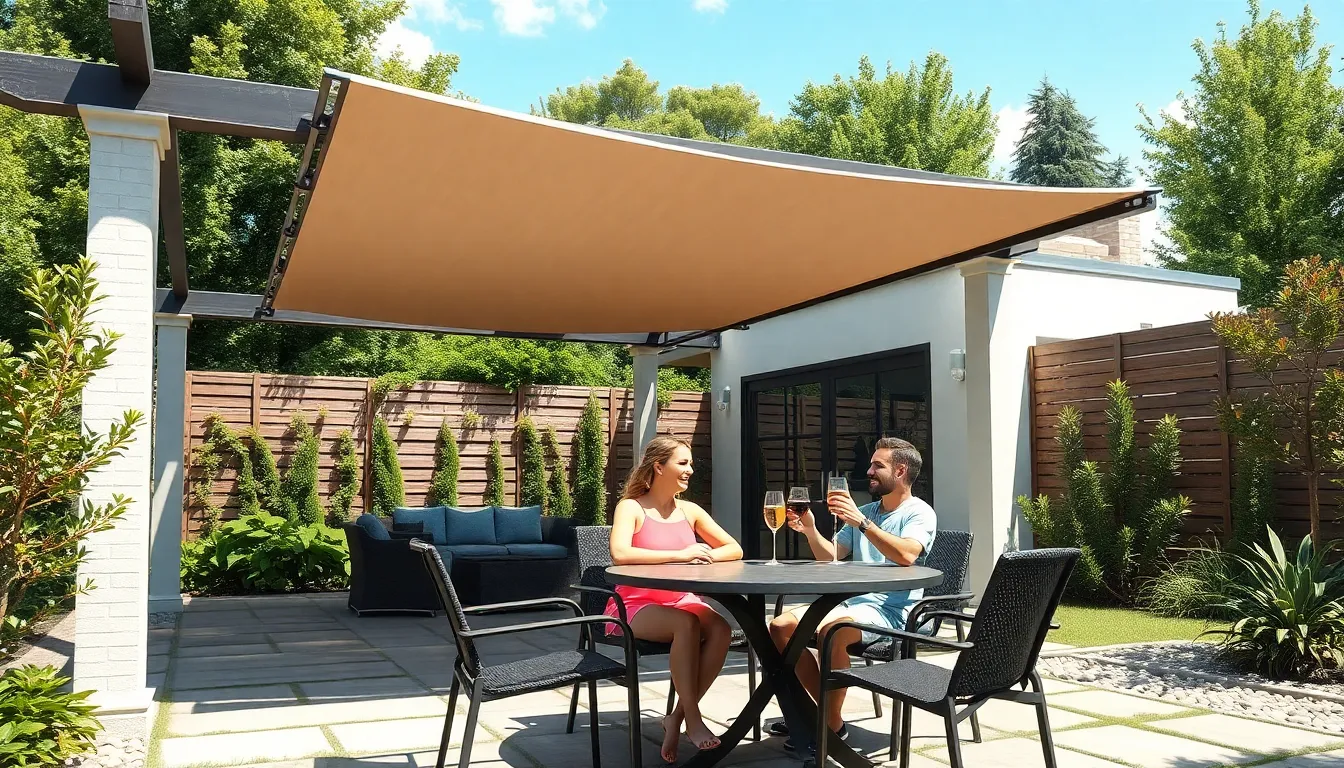
Installing a retractable canopy pergola system transforms your garden space into a versatile outdoor area that adapts to changing weather conditions throughout the day.
Provide Adjustable Sun Protection
Adjustable canopies let us control exactly how much sunlight enters our outdoor space, making the area perfect for various activities from morning coffee to evening dinner parties. Homeowners can customize their comfort level by extending the canopy during intense midday sun or retracting it completely for stargazing sessions. Smart technology integration takes this flexibility even further, allowing us to operate the system with smartphone apps or voice commands for maximum convenience.
Weather changes no longer dictate our outdoor plans when we have adjustable sun protection. Morning yoga sessions benefit from partial shade while afternoon barbecues require full coverage, and our retractable system accommodates both scenarios effortlessly. Temperature control becomes remarkably easier as we reduce heat buildup by up to 20 degrees under the extended canopy.
Choose Manual or Motorized Options
Manual systems offer budget-friendly answers for homeowners who enjoy hands-on control of their outdoor environment. Hand crank mechanisms provide reliable operation and require minimal maintenance, making them ideal for smaller pergolas or less frequent use. These systems typically cost 40-60% less than motorized alternatives while delivering the same fundamental functionality.
Motorized options bring luxury and convenience to larger pergola installations where manual operation might prove challenging. Remote control operation means we can adjust our canopy from anywhere in the garden or even from inside the house. Weather sensors can automatically retract the canopy during high winds or unexpected storms, protecting our investment without requiring constant monitoring.
Battery powered systems eliminate the need for electrical connections, while hardwired options integrate seamlessly with home automation systems. Installation complexity varies significantly between these choices, with manual systems typically requiring one day while motorized versions may need professional electrical work.
Select Weather-Resistant Fabric Materials
Weather-resistant fabrics ensure our pergola canopy maintains both functionality and beauty through multiple seasons of outdoor exposure. Polyester fabrics with UV protection coatings resist fading and degradation from constant sun exposure while maintaining their structural integrity. Canvas materials provide excellent durability and classic aesthetic appeal, though they require more frequent cleaning to prevent mildew in humid climates.
Specialized waterproof fabrics offer complete rain protection while maintaining breathability to prevent condensation buildup underneath the canopy. Marine grade vinyl delivers exceptional durability for coastal areas where salt air accelerates fabric deterioration. Acrylic fabrics strike an excellent balance between weather resistance and visual appeal, with many options featuring solution-dyed colors that won’t fade over time.
Fabric weight plays a crucial role in performance, with heavier materials providing better wind resistance but requiring stronger support mechanisms. UV protection ratings of 50+ SPF ensure our fabric choice blocks harmful rays while maintaining comfortable temperatures underneath the pergola.
Build a Pergola Around Existing Mature Trees
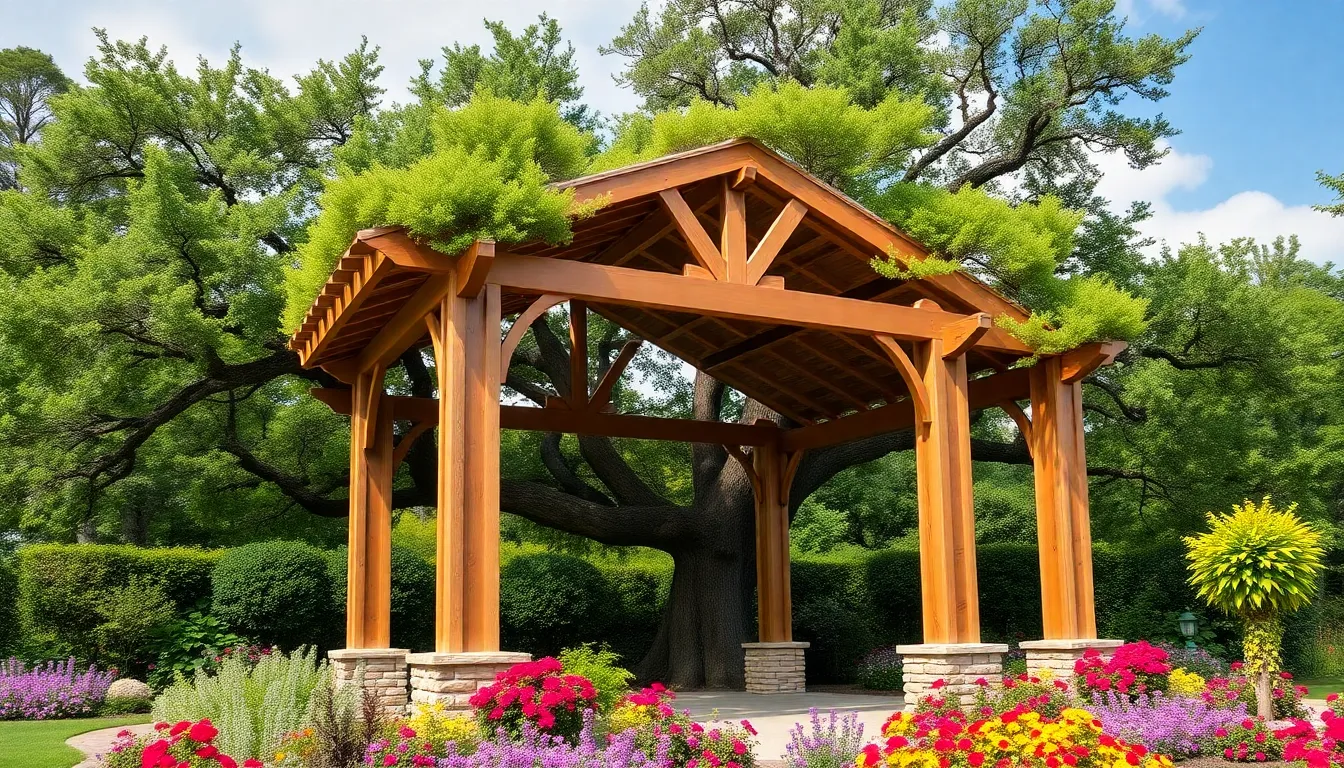
Creating a pergola around mature trees combines architectural beauty with natural elements, transforming your garden into a harmonious outdoor retreat.
Work with Natural Industry Features
Natural industry features become powerful design elements when we incorporate them thoughtfully into pergola construction. Slope, terrain, and existing plant life should guide our design decisions rather than being obstacles to overcome. Trees provide natural pillars that can support pergola structures while offering built-in shade and character that manufactured supports simply can’t match.
Working with your garden’s natural contours creates visual depth and frames stunning views that elevate the entire industry. Mature trees anchor the pergola design while their canopy provides immediate overhead coverage that complements the structure’s architectural lines. Emphasizing existing elements like rock formations, water features, or established plant beds helps create a unified outdoor space that feels intentionally designed rather than added as an afterthought.
Preserve Tree Health and Growth
Tree root systems require careful consideration during pergola foundation installation to prevent long-term damage to these valuable industry assets. Foundation placement must avoid major root zones, typically extending outward from the trunk at least as far as the tree’s canopy reaches. Proper planning ensures that concrete footings don’t interfere with nutrient and water absorption patterns that keep mature trees healthy.
Regular health monitoring becomes essential once we’ve integrated trees into pergola structures. Growth patterns may shift over time, requiring adjustments to the pergola’s framework or support systems. Avoiding root damage during construction prevents stress that could weaken the tree’s overall stability and longevity in your garden design.
Create Unique Architectural Elements
Design variability flourishes when we build pergolas around existing trees, allowing for modern, traditional, or mixed styles that complement both natural and architectural elements. Functional spaces emerge naturally as the tree-integrated pergola defines distinct areas for dining, seating, or gardening activities within your outdoor environment. Each mature tree offers different possibilities for creative structural answers that can’t be replicated with standard pergola designs.
Incorporating features like fire pits, planters, or outdoor lighting enhances both functionality and ambiance while working around the tree’s natural form. Custom brackets and supports can be designed to accommodate unusual trunk shapes or branching patterns, creating one-of-a-kind architectural elements that showcase the tree as a living centerpiece. These unique installations become conversation starters that demonstrate thoughtful integration of nature and design in your garden space.
Conclusion
Creating the perfect pergola for your garden opens up endless possibilities to transform your outdoor space into something truly spectacular. Whether you’re drawn to classic wooden designs with climbing vines or prefer sleek modern metal structures with integrated technology we’ve shown you how each approach can enhance your property’s value and your quality of life.
The beauty of pergolas lies in their incredible versatility. From supporting your vegetable garden’s climbing crops to creating elegant dining spaces with retractable canopies these structures adapt to your exact needs and lifestyle. You can incorporate smart storage answers maximize your growing potential or work around existing mature trees to create a harmonious blend of architecture and nature.
Your garden deserves a pergola that reflects your personal style while providing the functionality you need. With the right planning materials and design approach you’ll create an outdoor sanctuary that serves you beautifully for years to come.
Frequently Asked Questions
What is a pergola and why should I add one to my backyard?
A pergola is a versatile architectural structure that combines style and functionality in outdoor spaces. It creates defined outdoor rooms that enhance your living experience while increasing property value. Pergolas provide customizable shade and openness, serve as support for climbing plants, and can accommodate various design styles from rustic wooden frames to modern metal structures with integrated lighting.
What are the best materials for building a pergola?
Cedar is the top choice for wooden pergolas due to its durability and natural insect resistance. Pressure-treated pine offers an affordable alternative, while redwood provides exceptional beauty and teak delivers superior weather resistance. For modern designs, aluminum is the premier material for metal pergolas because it’s lightweight, weather-resistant, and requires minimal maintenance.
Which climbing plants work best with pergolas?
Fast-growing climbing plants like clematis, grape vines, wisteria, and honeysuckle are ideal for pergolas. These plants enhance both aesthetic appeal and functionality by providing additional shade and privacy. When selecting plants, consider their growth rate, maintenance requirements, and how well they complement your pergola’s design and your local climate conditions.
How do I size a pergola for outdoor dining?
For outdoor dining areas, plan for a minimum coverage of 8×10 feet to accommodate standard dining tables and seating. Allow additional space for larger gatherings and consider the flow of foot traffic around the dining area. Include weather protection elements like retractable shades and proper lighting systems to enhance functionality during evening meals.
Can pergolas be used in vegetable gardens?
Yes, pergolas are excellent additions to vegetable gardens. They provide support for climbing vegetables like peas, beans, and cucumbers, maximizing garden productivity while improving harvest accessibility and air circulation. Pergolas also help organize growing zones for efficient maintenance and crop rotation planning while enhancing the garden’s aesthetic appeal.
What are the benefits of retractable canopy pergola systems?
Retractable canopy systems offer adjustable sun protection, allowing you to control sunlight exposure for different activities and weather conditions. Many systems feature smart technology integration for remote operation convenience. Choose between manual and motorized options based on your budget and preference, and select weather-resistant fabric materials for durability and year-round appeal.
How can I incorporate storage into my pergola design?
Built-in storage solutions maximize pergola functionality while maintaining aesthetic appeal. Consider hidden storage compartments like benches with lift-up seats, floor-level compartments for garden supplies, hooks for tools, and built-in shelving for plant displays. These features improve organization and visual interest while keeping outdoor spaces tidy and functional.
What are multi-level pergola designs?
Multi-level pergolas feature varying height sections that create natural boundaries for different activities and add visual depth to outdoor spaces. A traditional three-tiered design typically includes zones for socializing, entryways, and gardens. This design approach accommodates diverse plant types at different levels while enhancing privacy, shade, and seasonal interest throughout your garden.

